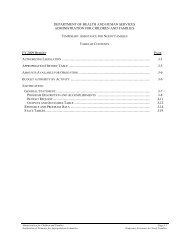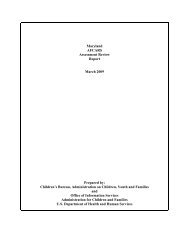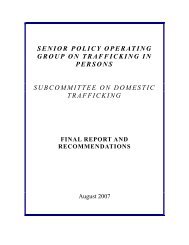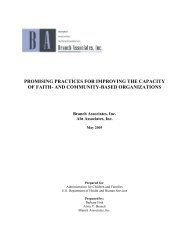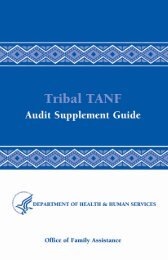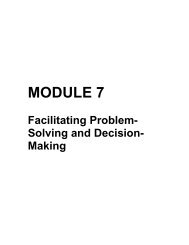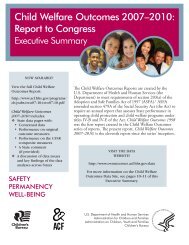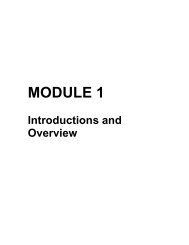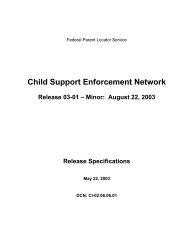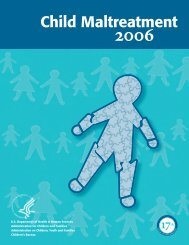Temporary Assistance for Needy Families Program Information ...
Temporary Assistance for Needy Families Program Information ...
Temporary Assistance for Needy Families Program Information ...
You also want an ePaper? Increase the reach of your titles
YUMPU automatically turns print PDFs into web optimized ePapers that Google loves.
<strong>Temporary</strong> <strong>Assistance</strong> <strong>for</strong> <strong>Needy</strong><strong>Families</strong> <strong>Program</strong>In<strong>for</strong>mation MemorandumU.S. Department ofHealth and Human ServicesAdministration <strong>for</strong> Children & <strong>Families</strong>Office of Family <strong>Assistance</strong>Washington, D.C. 20447Memorandum No. TANF-ACF-IM-2003-02 Date: September 17, 2003TO:State Agencies Administering the <strong>Temporary</strong> <strong>Assistance</strong> <strong>for</strong> <strong>Needy</strong><strong>Families</strong> (TANF) <strong>Program</strong> and Other Interested PartiesSUBJECT: Work Participation Rates For FY 2002BACKGROUND:The Personal Responsibility and Work Opportunity Reconciliation Act of1996 (PRWORA) established mandatory work requirements and minimumannual work participation rate standards <strong>for</strong> States operating a TANFprogram. States are subject to these minimum participation raterequirements beginning July 1997 or six months after the Stateimplementation of the TANF program. The Act establishes separateminimum participation rates each year <strong>for</strong> all families and two-parentfamilies. The minimum work participation rate standards <strong>for</strong> fiscal year(FY) 2002 are 50 percent <strong>for</strong> the all families rate and 90 percent <strong>for</strong> thetwo-parent families rate.PRWORA provides <strong>for</strong> a reduction in the minimum work participation ratestandards if the State’s average monthly assistance caseload decreased theprevious year in comparison to its average monthly caseload in FY 1995.The all families participation rate standard is reduced by the number ofpercentage points the overall caseload declined. The two-parentparticipation rate standard is reduced, at State option, by either (1) thenumber of percentage points the two-parent caseload declined or (2) thenumber of percentage points the overall caseload declined. However, thelaw specifies that any caseload reductions resulting from changes in Stateor Federal eligibility rules are excluded in calculating the credit.Adjustments of FY 2002 minimum participation standards, called the“caseload reduction credit,” are based on the caseload changes from FY1995 (in the State’s title IV-A program under prior law) to FY 2001.The Act also provides States the option to retain approved welfare re<strong>for</strong>mwaiver provisions that are inconsistent with the TANF provisions. Suchwaiver provisions may affect who is required to participate, the requiredhours of participation, and the countable activities. Thus, the participationrate calculation may apply differently <strong>for</strong> States retaining inconsistentwaiver provisions.
CONTENT: This memorandum transmits the work participation tables <strong>for</strong> FY 2002.All States were required to report work participation in<strong>for</strong>mation <strong>for</strong> all ofthe October 2001 - September 2002 fiscal year and are subject to the workparticipation standards <strong>for</strong> FY 2002 based on this in<strong>for</strong>mation.The FY 2002 national average all families work participation rate is 33.4percent. This represents a 2.9 percent decline from the 34.4 percent workparticipation rate attained in FY 2001. The FY 2002 national average twoparentfamilies work participation rate is 49.4 percent. This represents a3.3 percent decline from the 51.1 percent work participation rate attained inFY 2001. All States, the District of Columbia, Puerto Rico, and the VirginIslands met or exceeded their minimum all families work participation rate.One Territory – Guam – did not. Twenty-two States (Alabama, Cali<strong>for</strong>nia,Connecticut, Delaware, Florida, Georgia, Hawaii, Illinois, Indiana,Maryland, Minnesota, Mississippi, Nebraska, Nevada, New Jersey, NorthDakota, Oklahoma, South Dakota, Tennessee, Texas, Utah and Virginia)and two Territories (Puerto Rico and the Virgin Islands) did not have anytwo-parent families in the TANF program. Thus, they were not subject tothe two-parent work participation requirements. Of the twenty-eightStates, the District of Columbia, and Guam that had two-parent families intheir TANF program, twenty-five States met or exceeded their minimumtwo-parent families work participation rate. Five jurisdictions (Arkansas,District of Columbia, Guam, Missouri, and West Virginia) failed to meetthe two-parent work requirement. A State-by-State comparison of the FY2002 work participation rates with the FY 2001 work participation ratesshows that the all families work participation rates increased <strong>for</strong> 19 Statesand decreased <strong>for</strong> 34 States. The two-parent families work participationrate increased <strong>for</strong> 11 States and decreased <strong>for</strong> 19 States.All States, except Guam, received a reduction in their minimumparticipation rates <strong>for</strong> the all families rate and all States with a two-parentTANF program, except Guam, received reductions in their minimumparticipation rates <strong>for</strong> the two-parent families rate as a result of theapplication of the caseload reduction credit. Twelve States met the allfamilies work participation rate standard be<strong>for</strong>e application of the caseloadreduction credit. Three States (Montana, Rhode Island and Wyoming) metthe two-parent work participation rate standard be<strong>for</strong>e application of thecaseload reduction credit. The average caseload reduction credit <strong>for</strong> allfamilies was 52.7 percent and <strong>for</strong> two-parent families was 89.6 percent.Twenty-one States had sufficient caseload reduction credits that theirstandard <strong>for</strong> the all families work participation rate dropped to zero. OneState (Wyoming) had sufficient caseload reduction credits that its standard<strong>for</strong> the two-parent work participation rates fell to zero. In addition, waiverinconsistencies applied in calculating participation rates <strong>for</strong> 15 States(Delaware, Hawaii, Indiana, Kansas, Massachusetts, Minnesota, Montana,Nebraska, New Hampshire, Ohio, Oregon, South Carolina, Tennessee,
Texas, and Virginia).As shown in the attached work activity tables, an average of 546,618 adultsparticipated in work activities each month <strong>for</strong> an average of 28.5 hours perweek. This represents about 41.7 percent of all adults receiving TANFassistance. Of these participating adults over 349,400 adults participated<strong>for</strong> a sufficient number of hours in work activities to include the family inthe count toward meeting the participation rate. About 56.4 percent of theparticipating adults were engaged in unsubsidized employment. Another15.1 percent were engaged in job search and 14.7 percent were engaged ineither work experience or community service. (Because some individualswere engaged in multiple activities, the table total is in excess of 100percent.)There are no statutory work requirements or minimum participation ratestandards <strong>for</strong> families in “Separate State <strong>Program</strong>s” funded solely withState funds. Thirty States have established Separate State <strong>Program</strong>s thatprovide “assistance.” Nineteen States (Alabama, Cali<strong>for</strong>nia, Connecticut,Delaware, Florida, Georgia, Hawaii, Illinois, Indiana, Maryland,Minnesota, Nebraska, Nevada, New Jersey, Rhode Island, Tennessee,Texas, Utah, and Virginia) have moved all or part of their two-parentfamilies to Separate State <strong>Program</strong>s. For Separate State <strong>Program</strong>s the FY2002 national average all families work participation rate is 41.6 percentand the FY 2002 national average two-parent families work participationrate is 39.4 percent.States have been individually notified of their participation rates <strong>for</strong> FY2002. States that failed to meet their minimum work participation rate <strong>for</strong>either all families or two-parent families are subject to a penalty asrequired by section 409(a)(3) of PRWORA. However, States will have anopportunity to file a claim <strong>for</strong> good cause and/or submit a correctivecompliance plan to correct any failure to meet their FY 2002 minimumwork participation rate standard(s) be<strong>for</strong>e the Secretary will impose apenalty.ATTACHMENT: TANF Work Participation Rate Tables For FY 2002 (October 2001-September 2002)
INQUIRIES:Inquiries should be directed to the appropriate ACF RegionalAdministrator____________________Andrew S. BushDirectorOffice of Family <strong>Assistance</strong>



